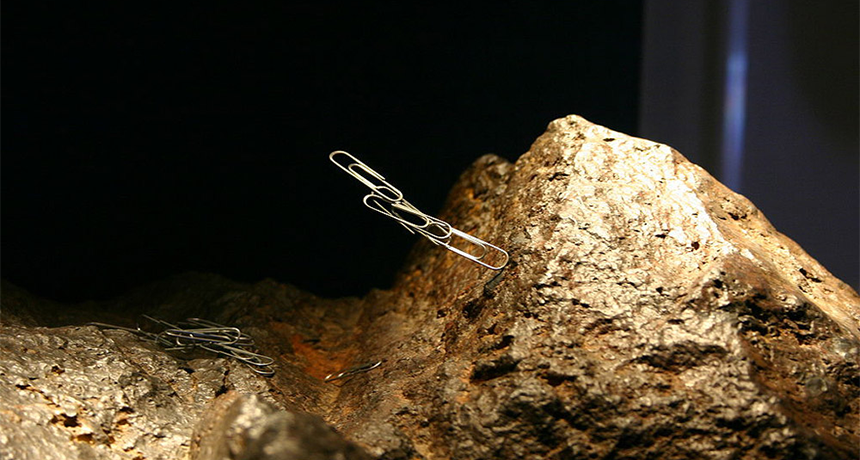Making rocks into magnets
Lab experiments show one way that certain types of stones can morph into magnets

Lodestone is the most magnetic and common type of natural magnet.
RYAN SOMMA/Wikimedia Commons
By Sid Perkins
Heat up a rock. Most likely, all you will get is a hot rock. But heat up the right type of stone to just the right temperature and you could end up with a magnet, scientists now report.
Long before people invented the small magnets that stick to refrigerators or the big magnets that pick up cars at the junkyard, people discovered natural magnets. The most magnetic and common type is a lodestone. It consists of a brownish-black mineral called magnetite. Lodestones are natural compasses: Suspend one by a thread or wire and it will rotate until its magnetic field is aligned with Earth’s magnetic field.
A magnetic field is the area around a material in which its magnetic forces can be detected. Those forces stem from the activity of tiny, negatively charged particles called electrons, which are within all atoms. A material’s magnetism is determined by the way its electrons move around the outside of its atoms’ nuclei — particularly those electrons that aren’t paired with other electrons in certain ways. If a large number of unpaired electrons rotate in the same direction (imagine a large number of tops spinning on a table or other flat surface), then an object’s magnetic field can be strong. If all of the unpaired electrons spin in random directions, the object’s magnetic field is either very weak or missing.
Some materials, such as lodestones, create a persistent magnetic field. Others with unpaired electrons, such as iron, can become magnetized when they’re placed within a magnetic field and their atoms rotate and align.
Scientists don’t know how some types of rocks, including lodestones, become so strongly magnetized. But new lab tests show how some other rocks can become naturally magnetized.
Charles Aubourg is a geologist at the University of Pau and the Adour Countries in France. He and his colleagues heated samples of a type of sedimentary rock to as much as 130 degrees Celsius (about 266 degrees Fahrenheit). Sedimentary rock is made from material eroded from other rocks. The eroded materials transform into stone when exposed to high pressure deep within Earth for a lengthy period of time, sometimes millions of years.
Aubourg’s team got its rock samples from northern France, but similar rocks can be found worldwide. Each sample contained large amounts of clay and silt (both of which are made of tiny particles eroded from other rocks). But importantly, the rocks also contained a small amount of an iron-bearing mineral called pyrite.
First, the team used a strong magnetic field to erase any magnetism naturally trapped in the sample. Then the researchers heated the rock inside a strong magnetic field according to a specific recipe: 25 days at 50 degrees Celsius, then 25 days at 70 degrees, 25 days at 80 degrees, 10 days at 120 degrees, and a final 10 days at 130 degrees. This temperature range is the same as that of rocks located between 2 kilometers and 4 kilometers deep in Earth’s crust, explains Aubourg.
The rocks’ magnetic field rose during each stage of heating. It increased most quickly during the earliest days of each step. The growing magnetism of the samples suggests that the heat triggered reactions that caused some of the pyrite to chemically transform into magnetic minerals.
Analyses conducted after the heating suggest that the magnetic minerals were very tiny grains of magnetite. These grains were so small, less than 20 nanometers across, that it would take more than 1,000 of them side by side to stretch across the width of a single human hair. The researchers reported their results online August 10 in the scientific journal Geochemistry, Geophysics, Geosystems.
Because the grains of magnetite were so small, looking for one “would be like trying to find a needle in a haystack,” says Douglas Elmore. He is a sedimentary geologist at the University of Oklahoma in Norman. Nevertheless, he notes, the evidence is convincing that the heating experiments created small grains of magnetite, not other types of magnetic minerals.
Studies that investigated rocks in their natural environment have hinted that rocks buried in shallow layers of Earth’s crust and heated there naturally can become magnetized, says Elmore. The new lab tests provide even stronger evidence that such magnetization occurs naturally, he adds.
Studying the magnetic field trapped in ancient rocks helps scientists better understand Earth’s history, including how the planet’s magnetic field has changed through time.







